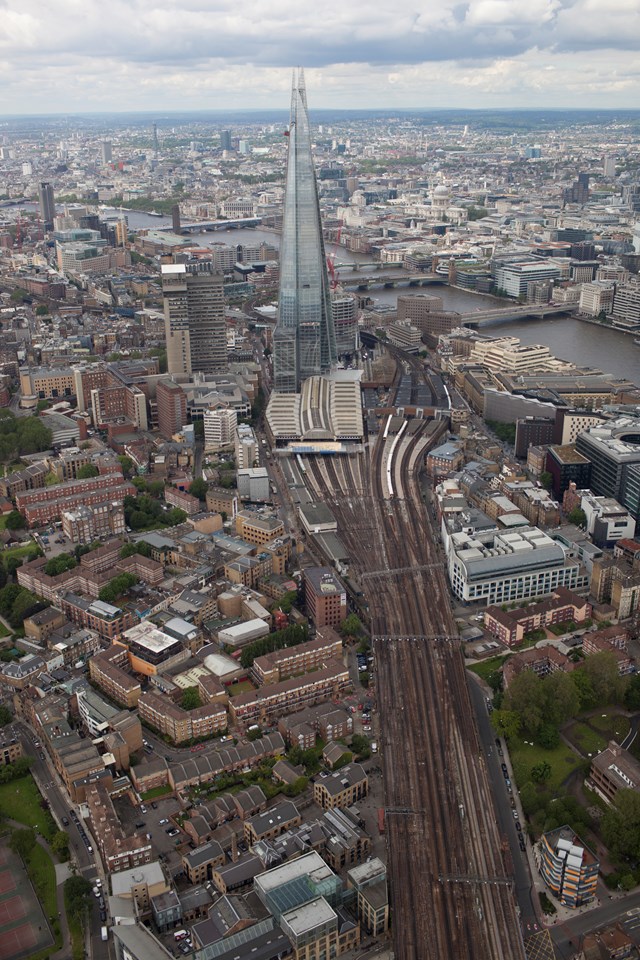Monday 23 Jul 2012
CHANGES TO LONDON BRIDGE STATION TO MAKE GAMES-TIME TRAVEL EASIER FOR PASSENGERS
- Region & Route:
- National
Network Rail has updated its plans for how London Bridge station will operate during the Olympic and Paralympic Games following a successful live rehearsal on 10 July. The changes are based on passenger feedback and a full review with transport partners, including train operators and London Underground.
The key changes are:
- More than 140 extra staff at the station during the Games period, including station experts and many of Network Rail's 600+ travel champions
- Eleven extra customer information screens feeding live information from the Olympic transport co-ordination centre. More than 300 screens have been installed across Network Rail’s London stations ahead of the Games
- An additional 140 prominent signs, many in elevated positions, helping both commuters and Games spectators use the station when crowd management systems are in operation
- Ten new goal post style signs to direct passengers to platforms
Robin Gisby, Network Rail managing director of network operations, said: "I’d like to thank passengers for taking part in the rehearsal at London Bridge recently and for their invaluable feedback, which we’ve used to update and improve our plans for the Games.
"The extra staff, signage and information that we have committed to provide will be crucial to keeping the station working at busy times – but it will still be a massive challenge given the huge numbers of additional passengers expected at London Bridge. Our advice remains for people to avoid the station if they can during the Games and to check GetAheadoftheGames.com for up-to-the-minute travel advice."
People are advised to avoid London Bridge station if at all possible during the Games. Day three of the Games (Monday 30 July) is expected to be the busiest for London Bridge, with an additional 69,000 people – including 50,000 spectators travelling to and from an equestrian event at Greenwich – using the station.
The start and finish times of the event mean spectators will be travelling against the usual flow of commuters. (ie they will be travelling out of central London to Greenwich during the morning peak and back in during the evening peak). As a result, passengers will not be able to board trains from platforms 1-6 at London Bridge station between 6-10pm that evening and are advised to use alternative stations, such as Cannon Street, Charing Cross and Blackfriars to board their trains.
Network Rail is distributing 30,000 leaflets to passengers at London Bridge this week as part of an ongoing campaign. The company is also contacting all businesses in the London Bridge areas, including PriceWaterhouseCoopers and Guy’s and St Thomas’ hospitals, urging staff to plan their journeys carefully during the Games. Transport for London will also be contacting London Bridge Underground station users by email and social media channels such as @GAOTG on Twitter.
Notes to editors
Key findings from the London Bridge rehearsal on 10 July are:
- London Bridge will be exceptionally busy at certain times during the Games and day 3 (30 July) in particular will be a massive challenge
- In the morning, the new walking routes between the national rail and London Underground stations added approximately 2-3 minutes to most journeys. This rose to around 10 minutes at the busiest time in the evening peak
- It is only possible for London Bridge national rail station to cope with the usual 200,000 commuters and up to 69,000 additional Games travellers per day if the crowd management systems used in the rehearsal, including one way systems, are in place. Without these, the station would not be able to operate safely and would have to close
- Travel demand management is working. People are starting to change their behaviour, with many people choosing to use start or end their journeys at Cannon Street or Charing Cross rather than London Bridge
- More than half of all passenger feedback related to inadequate signage and a desire for more specific passing information. Signage above head height was tested in the afternoon. This was far more visible to passengers
- The unexpected closure of the escalator next to Hay's Galleria had an impact on our ability to manage large numbers. We have been told that the escalator should be operational by the end of July
- Closer than ever working between Network Rail, train operators and London Underground is crucial to the safe, efficient operation of London Bridge station
Contact information
Passengers / community members
Network Rail national helpline
03457 11 41 41
Latest travel advice
Please visit National Rail Enquiries
Journalists
Network Rail press office - National
020 3356 8700
mediarelations@networkrail.co.uk
About Network Rail
We own, operate and develop Britain's railway infrastructure; that's 20,000 miles of track, 30,000 bridges, tunnels and viaducts and the thousands of signals, level crossings and stations. We run 20 of the UK's largest stations while all the others, over 2,500, are run by the country's train operating companies.
Usually, there are almost five million journeys made in the UK and over 600 freight trains run on the network. People depend on Britain's railway for their daily commute, to visit friends and loved ones and to get them home safe every day. Our role is to deliver a safe and reliable railway, so we carefully manage and deliver thousands of projects every year that form part of the multi-billion pound Railway Upgrade Plan, to grow and expand the nation's railway network to respond to the tremendous growth and demand the railway has experienced - a doubling of passenger journeys over the past 20 years.
Follow us on Twitter: @networkrail
Visit our online newsroom: www.networkrailmediacentre.co.uk

